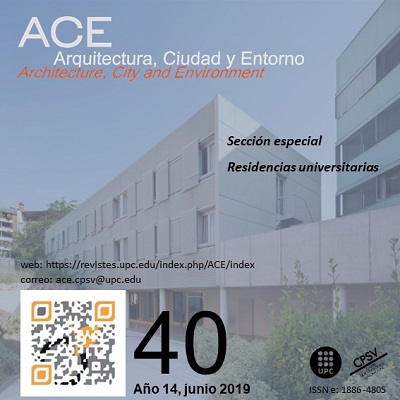The values of compactness and density in the residential fabrics of the periphery of the Spanish intermediary cities throughout the 20th century
DOI:
https://doi.org/10.5821/ace.14.40.5690Keywords:
Urban morphology, Malaga, Murcia, Valladolid, housingAbstract
Objective
The objective of this paper is to make a study of the formal variations, through the analysis of four parameters of the density, of the residential fabrics used, during the XX century, in the construction of the periphery of the Spanish intermediate cities.
Methodology
The cases of the cities of Málaga, Murcia and Valladolid are analyzed. From a compilation of bibliographic and cartographic information, the urban evolution of this cities during the period are defined and the urban residential fragments constructed in each of the periods are delimited. Later, the values of compactness, density, levels and open space ratio of each of these fragments are obtained from cadastral cartography through operations in geographic information systems (GIS). Finally, a comparative reading of the previous values is performed.
Conclusions
The conclusions have shown a progressive decrease in the compactness of residential fabrics, accompanied by a rise in number of floors during the first half of the century, followed by a decrease in the last decades. These variations originated the increase of the density until the end of the Spanish developmentalism and its descent later, as well as a progressive increase of the availability of open spaces by built surface.
Originality
This research contrasts, through the parameters studied, dynamics that had not yet been proven for this type of cities extensively to all the residential fragments built during the period.
Downloads
Published
Issue
Section
License
| INTELECTUAL PROTECTION CRITERIA |
At this moment, it is count with the "Oficina Española de Patentes y Marcas", while global protection it is being processed by the World Intelectual Property Organization (OMPI/WIPO). Nevertheless the International Standard Serial Number Office (ISSN) has given the following numbers ISSN: 1886-4805 (electronic version) and 1887-7052 (paper version). All articles will be peer reviewed, using double blind reviewing. |
| COPYRIGHT |
The article contents and their comments are authors exclusive liability, and do not reflect necessarily the journal editor commitee's opinion. All ACE published works are subject to the following licence CC BY-NC-ND 3.0 ES http://creativecommons.org/licenses/by-nc-nd/3.0/es/ It implies that authors do not hold nor retain the copyright without restrictions but only those included in the licence. |





































